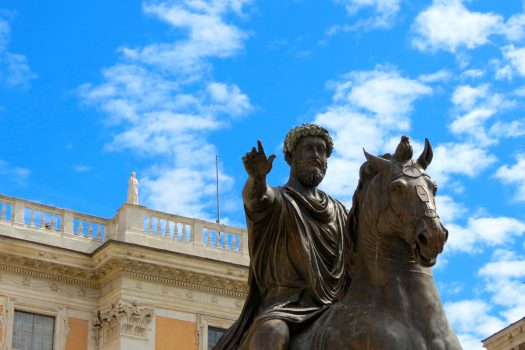The only remaining equestrian statue from the Roman Empire is the well-known statue of Emperor Marcus Aurelius (AD 121–180). It is not only the oldest equestrian statue in existence, but it has apparently such an aura that it has served for many centuries, and still does today, as an inspiring example of what an equestrian statue should look like.
Many a mighty ruler has wanted to be represented in the same way.
The statue portrays the last of those who are termed the ‘good emperors’ of the Roman Empire; the first five emperors, who had no blood ties with their predecessors. By the standards of his time, Marcus Aurelius was a lenient and humanitarian ruler, but he regarded the Christians as enemies of the state. His statue was the only one to survive from classical times because the citizens of ancient Rome mistakenly thought it was a representation of Emperor Constantine, the first Christian emperor.
The statue was probably erected either in AD 176, as part of the honours paid to the emperor in connection with his triumph over the Germanic tribes, or immediately after his death in AD 180.
At that time, there were quite a number of equestrian statues in Rome. The late imperial descriptions of the town mention at least 22 called equi magni, meaning larger than life size.
There is no reliable information as to the original site of the Marcus Aurelius statue. It can only be said that it was erected for a public dedication, and therefore that the most probable original setting was the Roman Forum or the square with the dynastic temple that encircled the Antonine column. The statue is recorded as having stood in the Lateran Palace, which is adjacent to the Archbasilica of St John Lateran (housing the cathedra: the ecclesiastical seat of the Pope) in the tenth century, but it is likely that it had already been there from the end of the eighth century. The statue was moved in 1538 to Capitoline Hill, the seat of the town’s authorities. Michelangelo was entrusted with the task of rearranging the setting of the statue. He did not constrain himself to developing a straightforward design for a suitable placing of the monument, but transformed the statue into the visual focus of the Piazza del Campidoglio.
A survey after a terrorist bomb attack on the Palazzo Senatorio in 1979 revealed that the statue was severely threatened by corrosion and that it was suffering from an alarming problem due to some fissures in the legs of the horse. Early in 1981, the statue was removed from its base and transferred to a restoration laboratory on Capitoline Hill. After extensive studies to evaluate the statue’s condition and the procedures to be applied to the bronze, the task of restoration began. The work lasted until the end of 1988, when a new stage in the equestrian monument’s life began.
The weakness of both the structure and the surface of the material raised the problem of the protection to be given to the statue if it was placed in the open air. It was clear that the antique bronze would only be adequately protected only if isolated from the thermal and mechanical stresses that come from an outdoor placement.
The problem of how to preserve the unity of the original arrangement of the Piazza del Campidoglio was solved in 1997 by placing a bronze copy of the original on Michelangelo’s base at the centre of the square
A pavilion in the nearby Palazzo dei Conservatori, specially designed for this equestrian statue, offered the required sheltered setting under monitored conditions.


























